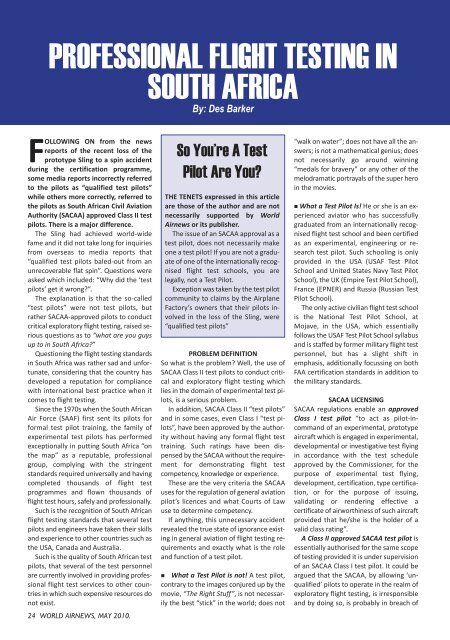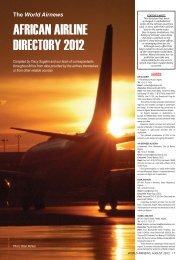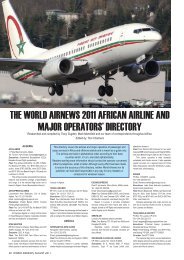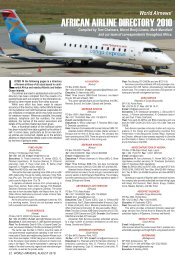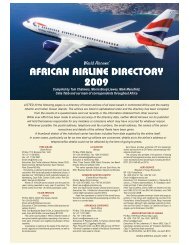May 2010 covers_Covers.qxd - World Airnews
May 2010 covers_Covers.qxd - World Airnews
May 2010 covers_Covers.qxd - World Airnews
Create successful ePaper yourself
Turn your PDF publications into a flip-book with our unique Google optimized e-Paper software.
PROFESSIONAL FLIGHT TESTING IN<br />
SOUTH AFRICA<br />
By: Des Barker<br />
FOLLOWING ON from the news<br />
reports of the recent loss of the<br />
prototype Sling to a spin accident<br />
during the certification programme,<br />
some media reports incorrectly referred<br />
to the pilots as “qualified test pilots”<br />
while others more correctly, referred to<br />
the pilots as South African Civil Aviation<br />
Authority (SACAA) approved Class II test<br />
pilots. There is a major difference.<br />
The Sling had achieved world-wide<br />
fame and it did not take long for inquiries<br />
from overseas to media reports that<br />
“qualified test pilots baled-out from an<br />
unrecoverable flat spin”. Questions were<br />
asked which included: “Why did the ‘test<br />
pilots’ get it wrong?”.<br />
The explanation is that the so-called<br />
“test pilots” were not test pilots, but<br />
rather SACAA-approved pilots to conduct<br />
critical exploratory flight testing, raised serious<br />
questions as to “what are you guys<br />
up to in South Africa?”<br />
Questioning the flight testing standards<br />
in South Africa was rather sad and unfortunate,<br />
considering that the country has<br />
developed a reputation for compliance<br />
with international best practice when it<br />
comes to flight testing.<br />
Since the 1970s when the South African<br />
Air Force (SAAF) first sent its pilots for<br />
formal test pilot training, the family of<br />
experimental test pilots has performed<br />
exceptionally in putting South Africa “on<br />
the map” as a reputable, professional<br />
group, complying with the stringent<br />
standards required universally and having<br />
completed thousands of flight test<br />
programmes and flown thousands of<br />
flight test hours, safely and professionally.<br />
Such is the recognition of South African<br />
flight testing standards that several test<br />
pilots and engineers have taken their skills<br />
and experience to other countries such as<br />
the USA, Canada and Australia.<br />
Such is the quality of South African test<br />
pilots, that several of the test personnel<br />
are currently involved in providing professional<br />
flight test services to other countries<br />
in which such expensive resources do<br />
not exist.<br />
24 WORLD AIRNEWS, MAY <strong>2010</strong>.<br />
So You’re A Test<br />
Pilot Are You?<br />
THE TENETS expressed in this article<br />
are those of the author and are not<br />
necessarily supported by <strong>World</strong><br />
<strong>Airnews</strong> or its publisher.<br />
The issue of an SACAA approval as a<br />
test pilot, does not necessarily make<br />
one a test pilot! If you are not a graduate<br />
of one of the internationally recognised<br />
flight test schools, you are<br />
legally, not a Test Pilot.<br />
Exception was taken by the test pilot<br />
community to claims by the Airplane<br />
Factory’s owners that their pilots involved<br />
in the loss of the Sling, were<br />
“qualified test pilots”<br />
PROBLEM DEFINITION<br />
So what is the problem? Well, the use of<br />
SACAA Class II test pilots to conduct critical<br />
and exploratory flight testing which<br />
lies in the domain of experimental test pilots,<br />
is a serious problem.<br />
In addition, SACAA Class II “test pilots”<br />
and in some cases, even Class I “test pilots”,<br />
have been approved by the authority<br />
without having any formal flight test<br />
training. Such ratings have been dispensed<br />
by the SACAA without the requirement<br />
for demonstrating flight test<br />
competency, knowledge or experience.<br />
These are the very criteria the SACAA<br />
uses for the regulation of general aviation<br />
pilot’s licences and what Courts of Law<br />
use to determine competency.<br />
If anything, this unnecessary accident<br />
revealed the true state of ignorance existing<br />
in general aviation of flight testing requirements<br />
and exactly what is the role<br />
and function of a test pilot.<br />
n What a Test Pilot is not! A test pilot,<br />
contrary to the images conjured up by the<br />
movie, “The Right Stuff”, is not necessarily<br />
the best “stick” in the world; does not<br />
“walk on water”; does not have all the answers;<br />
is not a mathematical genius; does<br />
not necessarily go around winning<br />
“medals for bravery” or any other of the<br />
melodramatic portrayals of the super hero<br />
in the movies.<br />
n What a Test Pilot Is! He or she is an experienced<br />
aviator who has successfully<br />
graduated from an internationally recognised<br />
flight test school and been certified<br />
as an experimental, engineering or research<br />
test pilot. Such schooling is only<br />
provided in the USA (USAF Test Pilot<br />
School and United States Navy Test Pilot<br />
School), the UK (Empire Test Pilot School),<br />
France (EPNER) and Russia (Russian Test<br />
Pilot School).<br />
The only active civilian flight test school<br />
is the National Test Pilot School, at<br />
Mojave, in the USA, which essentially<br />
follows the USAF Test Pilot School syllabus<br />
and is staffed by former military flight test<br />
personnel, but has a slight shift in<br />
emphasis, additionally focussing on both<br />
FAA certification standards in addition to<br />
the military standards.<br />
SACAA LICENSING<br />
SACAA regulations enable an approved<br />
Class I test pilot “to act as pilot-incommand<br />
of an experimental, prototype<br />
aircraft which is engaged in experimental,<br />
developmental or investigative test flying<br />
in accordance with the test schedule<br />
approved by the Commissioner, for the<br />
purpose of experimental test flying,<br />
development, certification, type certification,<br />
or for the purpose of issuing,<br />
validating or rendering effective a<br />
certificate of airworthiness of such aircraft<br />
provided that he/she is the holder of a<br />
valid class rating”.<br />
A Class II approved SACAA test pilot is<br />
essentially authorised for the same scope<br />
of testing provided it is under supervision<br />
of an SACAA Class I test pilot. It could be<br />
argued that the SACAA, by allowing ‘unqualified’<br />
pilots to operate in the realm of<br />
exploratory flight testing, is irresponsible<br />
and by doing so, is probably in breach of


